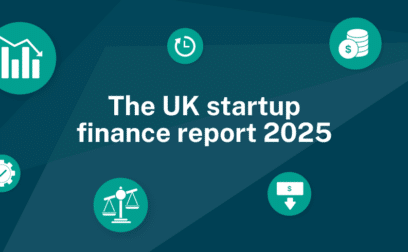Please note: EIS amounts changed in the Autumn Budget 2025 and this page reflects those changes.
At some stage in their journey, many businesses require more investment to keep momentum going. However, without taking on expensive debt, it can often be difficult to raise the needed funds. The government-supported Enterprise Investment Scheme aims to ease this burden by giving generous tax relief to individuals who invest in growing businesses. They invest, you get your funding, they get a tax break. It’s a win-win situation. Since introduction in 1994, EIS has helped over 32,000 businesses raise more than £24 billion in investments. Give your business the boost it needs with EIS – the investment scheme that’s built for growth.
What is the Enterprise Investment Scheme?
EIS is a UK Government-backed investment programme designed to support high-growth potential, smaller and younger companies. However, business owners seeking funds should be aware that EIS is not a source of venture capital. It is an incentive scheme. The Government does not provide any cash in this programme. Instead, it provides generous tax relief to individual investors who buy shares in qualifying businesses – which should make it easier for those companies to attract the investment they need. Note that businesses seeking fresh capital may also raise funds from other companies under EIS, although corporate investors are not eligible for tax relief on their investment.
How does EIS work?
Unlike its sister programme SEIS (the Seed Enterprise Investment Scheme), which supports startups and very new businesses, EIS supports larger and more established organisations – those with up to seven years trading history and 250 employees. Businesses seeking to raise capital with EIS should first secure proof of their eligibility for the scheme by obtaining Advance Assurance from HMRC. This will assure investors that the company they are investing in is eligible for the scheme. If it’s not, they will not get their tax breaks. Individual or corporate investors can invest up to £1 million per tax year and the company can accept up to £10 million per tax year and no more than £24 million EIS funding total.
EIS has different criteria for knowledge intensive companies (KIC) which are typically those with high research/development costs and requirements. These companies can accept EIS funding within ten years of trading and may have up to 500 employees. Individual or corporate investors can invest up to £2 million per tax year in KIC businesses which may accept up to £20 million per tax year and up to £40 million EIS funding total.
In both cases, only individual, private investors may claim a tax break. Corporate investors may invest under EIS, but they are not eligible for tax relief.
| Key investment rules in EIS for KIC and Non-KIC companies | ||
| Non-KIC | KIC | |
| Company location | UK | UK |
| Maximum trading age of business | 7 years | 10 years |
| Maximum number of employees | 250 | 500 |
| Maximum gross assets | £30m | £30m |
| Maximum investment allowed | £24m | £40m |
| Corporate investors allowed | Yes, but no tax relief | Yes, but no tax relief |
| Funds must be spent within | 2 years | 2 years |
| Initial tax relief rate | 30% | 30% |
| Capital Gains Tax relief | Yes | Yes |
| Loss relief | Yes | Yes |
What are the eligibility criteria for a business?
Companies can use EIS if they:
- Have a permanent establishment in the UK
- Are not trading on a recognised stock exchange at the time of the share issue and do not plan to do so
- Have been trading for less than seven years, (ten years with KIC)
- Have no more than 250 full-time employees at the time the new shares are issued, (500 employees with KIC)
- Do not control another company other than qualifying subsidiaries
- Are not controlled by another company, or do not have more than 50% of their shares owned by another company
- Do not expect to close after completing a project or series of projects
- Do not have gross assets worth more than £30 million before any shares are issued, and not more than £35 million immediately afterwards
Additionally, investments must be used for a qualifying trade. Most trades are eligible for EIS, but companies may not qualify if more than 20% of their trade includes things like:
- Coal or steel production
- Farming or market gardening
- Leasing activities
- Legal or financial services
- Property development
- Running a hotel
- Running a nursing home
- Generation of energy, such as electricity and heat
- Production of gas or other fuel
- Exporting electricity
- Banking, insurance, debt, or financing services
If in doubt, register with Swoop to find out if your trade is eligible for EIS.
What’s the maximum investment amount?
There are different investment limits for companies that qualify as knowledge intensive and those that don’t:
Non-KIC companies:
- Investors may each invest up to £1m per tax year
- Company may accept up to £10m per tax year
- Company may accept up to £24m total
KIC companies:
- Investors may each invest up to £2m per tax year
- Company may accept up to £20m per tax year
- Company may accept up to £40m total
EIS rules for companies
In addition to the rules on eligibility and investment limits (see above), companies seeking fresh capital using EIS must also ensure:
- The investment is not used for prohibited purposes, (see below)
- The investment poses a risk of loss of capital for the investor, (also known as ‘risk to capital’)
- The investment must be spent within 2 years of the investment, or if later, the date the company started trading
- The company must follow the scheme rules for at least 3 years after the investment is made – otherwise tax relief will be withdrawn from investors
- The shares the company issues for EIS investment must be full-risk ordinary shares which are not redeemable and carry no special rights to company assets
- Issued shares must be paid up in full, in cash, when they’re issued
- The company should have a way to accept payment before shares are issued
EIS benefits for companies
EIS offers two key benefits to companies:
- Generous tax relief makes an investment pitch more attractive to potential investors
- It can help companies avoid incurring debt to fund their future growth
EIS can take your investment pitch from just one of many to one of a kind. Register to speak with an EIS expert and find out how to make your pitch stand out.
EIS rules for investors
Almost anyone can invest in EIS-supported companies and there are few restrictions on their investors. However, to claim EIS tax relief an investor must:
- Be liable to pay UK taxes – which may also apply to some non-UK residents
- Not already hold shares in the company that are not SEIS or EIS shares, except for subscriber shares
- Not be an employee, or a director of the company, unless complex Business Angel rules apply
- Not, together with their ‘associates’, hold more than 30% of the company (associates are business partners, spouses, lineal relatives, but not siblings)
EIS benenfits for investors
EIS offers substantial tax relief to individual but not corporate investors. The tax breaks come in four flavours.
- Income tax relief: Up to 30% income tax relief on investments up to £1 million for EIS, or up to £2 million if invested in knowledge intensive companies. Note that EIS allowances are allocated individually. This means a married couple could separately invest up to £2 million each tax year and both would be eligible for full Income Tax relief
- Capital gains tax disposal relief: Any gain is capital gains tax (CGT) free if the investment is held for at least three years
- Capital fains tax re-investment relief: All capital gains tax can be deferred if the gain is re-invested in EIS-qualifying shares
- Loss relief: If the shares are disposed of at a loss, (or if the company goes bankrupt), investors can set the loss against any income tax due for that year or the previous year
- Additionally, shares purchased using EIS and held for at least two years, are exempt from inheritance tax if they are passed along via will or probate
What can a business use the funds for?
EIS rules state that invested funds must be used to grow and develop the business. Although this broad description may indicate many ways to spend the cash, there are restrictions on usage:
- Funds cannot be used to acquire assets or another company; this includes a trade, intangible assets, and goodwill
- The company cannot use the investment to repay any current or outstanding loans
- The company cannot use EIS monies to pay cash out to shareholders
- The investment cannot be used to acquire assets that can be resold by the company with little to no variance from the purchase price if the company were to fail. (Such as real estate)
- The company cannot use the investment to purchase land or finance the entirety of a land lease
- Where 20% or less of a company’s overall trade is excluded, EIS investment cannot be used by this excluded trade
- Production companies cannot use the investment to finance a film. The investment must be used to grow and develop the company’s internal infrastructure
EIS – a simplified example
The scheme may seem complex, but the core elements are quite simple. For the investor, EIS works like this:
| EIS examples – Investor’s perspective | ||
| Example 1 | Example 2 | |
| Situation | The company does very well and doubles its value. The investor holds their shares for three years | The company value stays the same. The investor holds their shares for three years |
| Investment | £100,000 | £100,000 |
| Income tax relief – 30% (as a reduction in their tax bill) | £30,000 | £30,000 |
| Sale of shares | £200,000 | £100,000 |
| Capital Gains Tax | None – investment held for three years | None – investment held for three years |
| Investor gains | £130,000 – £30k from tax relief and £100k from sale | £30,000 – from tax relief |
EIS. vs SEIS – what’s the difference
By now you know that the Enterprise Investment Scheme supports larger and more established businesses – those with up to seven years trading history and 250 employees. The Seed Enterprise Investment Scheme (SEIS), however, targets investment for early-stage companies – those with less than three years trading history and 25 employees. Individual investors (no companies) can invest up to £200,000 in an SEIS business per tax year, and SEIS companies can accept no more than £250,000 SEIS funding total.
What is Advance Assurance?
Investors seeking to invest in EIS need to know the company they are investing in is eligible for the appropriate scheme. If it’s not, they won’t get their tax breaks. Businesses can obtain proof of their eligibility for EIS by seeking Advance Assurance (AA) from HMRC. (Advance Assurance will not tell the company if an investor is eligible for EIS).
Applications for AA can be filed by the company secretary, a director, or a trustee if the social enterprise is a charitable trust. They will need to provide details of potential investors as well as the following:
- Forecast of how much money the company hopes to raise
- Business plan and financial forecasts
- A copy of the latest accounts if available
- List of which companies will use the investments
- Details of all trading and activities to be conducted, plus an estimate of how much the company expects to spend on each activity
- A list of any amounts, dates, and venture capital schemes under which the company has previously received an investment
- Up to date copy of the memorandum and articles of association and details of any changes the company expects to make
- A copy of the register of members from the date of application for Advance Assurance
- Latest draft of any documents used to explain the investment proposal to potential investors.(Company ‘pitch’ document).
- Details of any other agreements between the company and the shareholders or VCT
- A signed letter from one director or trustee if the company is allowing an agent to act on their behalf
- A completed checklist for EIS with the Advance Assurance application form
- Any other documents to show the company meets the qualifying conditions for the EIS
HMRC will contact the applicant after they have made their decision. If their answer is positive, they will provide a statement that says the investment is likely to qualify for EIS. This can be shown to potential investors. Note the word ‘likely’ in HMRC’s statement. It is an indication of eligibility, not a cast-iron guarantee. If HMRC declines to offer EIS, they will usually say why. The adjudication process can take up to eight weeks.
How long does Advance Assurance last?
A company’s EIS Advance Assurance from HMRC does not expire. However, changes to the company’s situation from the time of application to the point of share issuance may make their AA invalid. (For example, performing a non-qualifying trade).
What would happen if an EIS-invested company goes bust?
By their very nature, EIS companies are unquoted SMEs working in rapid growth areas. Often, this involves greater risk, which may increase the chance of failure. Should an EIS supported company fall into liquidation, the investor may set their losses against their capital gains tax bill or their income tax bill – whichever suits their individual needs. Note that loss relief may not cover the entire original investment, and some loss of capital may still occur.
What is an EIS compliance statement (EIS1)?
An EIS compliance statement, (known as EIS1), is a form that must be completed by the company and sent to HMRC after the issuance of EIS shares. Without this form, investors cannot claim their tax relief. EIS1 lists the investors who have requested EIS3 or EIS5 certificates to claim tax relief and contains a declaration that, as at the time of the form’s completion, the company has met the requirements for EIS and that it will continue to meet all requirements of the scheme for the relevant period.
Companies must submit an EIS1 compliance statement within either two years from the date on which the company had been conducting its qualifying business activity for four months, or within two years of the end of the tax year in which the shares were issued (whichever is later).
EIS vs. Venture Capital Trusts (VCTs) – what’s the difference?
Firstly, there’s the yawning gap between the investment caps on both schemes. EIS will allow up to £2 million investment per investor, per tax year, whereas VCT will allow only £200,000 per investor, per tax year. However, beyond the numbers, the biggest difference is in the management of the investments.
With EIS, the investor is largely on their own. They pick the company, they allocate their funds, they observe the performance of their investment, and they make the call on when to exit from the opportunity. It’s a hands-on affair. Alternatively, with VCTs, the investor places their funds in the care of a Venture Capital Trust – an investment company listed on the stock exchange that buys shares in high potential, unquoted businesses. Think of VCTs as adventurous money managers – they seek high-potential investments, allocate client funds to those opportunities, observe progress, and then decide when to step out of the deal. Apart from choosing their fund manager, the investor does very little with a VCT. They still invest in high potential businesses, but most of the footwork and paperwork is done for them – and of course, they pay management fees for the convenience. According to the Government, there were 40 active VCTs in the UK raising funds and 57 VCT’s managing funds in 2020/21.
In addition to the fact that EIS will allow ten times the investment compared to VCT, and that one scheme is fully managed and one is not, there are other differences in the structure of the schemes:
| EIS vs VCTs, comparisons | ||
| EIS | VCT | |
| Management | Investor | Fund Manager |
| Maximum investment per investor per tax year | £1 million £2 million for KIC | £200,000 £200,000 for KIC |
| Maximum investment (company) per tax year | £10 million £20 million for KIC | £10 million £20 million for KIC |
| Maximum investment (company) total | £24 million £40million for KIC | £24 million £40 million for KIC |
| Income Tax relief | 30% | 20% |
| Holding period before cash out | 3 years | 5 years |
| One year income tax carry-back | Yes | No |
| Dividends | Taxable | Exempt |
| Capital Gains Tax | Gains exempt after 3 years | Gains exempt |
| Capital Gains Tax deferral relief | Yes | No |
| Capital Gains Tax holiday | No | No |
For companies seeking funds, EIS presents a direct path to the investor, but that also brings the headache of finding those investors and presenting an investment case that may not be so easily understood by non-professionals. (However, it is worth noting that VCTs can be picky about the companies or sectors they invest in. It may not be easy for some businesses to secure the backing of a VCT for their funding needs). Additionally, EIS may mean the company has to deal with more investors (and their demands) than they would with VCT, where the fund acts as the go-between the company and the investors. VCTs may also bring experienced venture-capital managerial support to the deal that could give the business an unexpected boost.
For investors, the choice between EIS and VCT comes down to personal goals. Those with a larger investment and risk appetite and who may wish to cash out after three years instead of five years with VCT, may consider EIS as their best option. EIS also offers income tax carry back and capital gains tax deferral – useful options for those trying to limit their tax exposure. Alternatively, those who prefer the ease and reassurance of full funds management, and like the idea of immediate capital gains tax exemption and their annual dividends paid tax free may find VCT their best investment choice.
What is EIS carry back?
EIS investments offer a “carry back” facility, which means investors can choose for all or part of their EIS eligible shares purchased in one tax year to be treated as though they had been purchased in the previous tax year. This gives EIS investors the option to offset the tax relief against income tax from the previous year, potentially doubling their amount of tax allowance.
What is ‘EIS pending’ & ‘EIS partial’?
These are terms for the EIS status of a company’s investment proposal (pitch).
- ‘EIS pending’ means the company has applied to HMRC for EIS Advance Assurance but is still waiting to receive written confirmation. In this situation, confirmation of whether the company has received Advance Assurance will typically be given to investors in the statutory cooling off email sent after the pitch closes.
- ‘EIS partial’ means EIS is available for a portion, but not all, of the raise. For example, if a business raising £1,000,000 might have only £300,000 of that raise as EIS-eligible, then the pitch document will display ‘EIS Partial.’
Can a director claim EIS?
Yes and no. It’s a question of payment. For EIS, individuals cannot claim tax relief if, at the time the shares are issued, they’re a paid director of the company, unless their payment is a ‘permitted payment’. A permitted payment may be:
- Reimbursement of work-related expenses.
- Reasonable interest on loans to the company.
- Dividend which does not exceed a normal return on the amount invested.
- Payment for supplying goods at their market value, (no profit).
- Payment of reasonable commercial rent.
- Reasonable payment for services provided within their trade or profession, other than secretarial, managerial, or similar services to the company – these must be included in their accounts for tax purposes
Directors may also be able to claim tax relief if, at the time the shares are issued, they:
- Are an unpaid director of the company (and are not entitled to any payment)
- Have not previously been involved in the same trade that the company is seeking investment for.
If you become a paid director, you can keep any income tax relief you previously received. You can also claim tax relief under EIS after becoming a paid director if either you were:
- Issued shares before you became a paid director, and any new shares are issued within either three years of the original share issue or the date the company started trading
- Issued with SEIS shares while you were a paid director of the company, and the new EIS share issue is within three years of the SEIS share issue.
How does an investor claim EIS tax relief on a self-assessment tax return?
Assuming HMRC agrees that the company and investments are eligible for EIS tax relief, the company will receive EIS3 certificates for each investor. These documents carry a unique investment reference number (UIR).
To claim EIS tax relief on a self-assessment tax return, the investor will need to enter details of each investment in the ‘Any other information’ section of their tax return. The details required for each investment are:
- The UIR number as shown on the EIS3 certificate.
- The name of the company invested in.
- The amount on which they’re claiming relief for this year.
- The date of issue of the shares.
How can my business take advantage of EIS?
EIS can provide young businesses with a unique opportunity to turbo-charge their growth. In a company’s early years, profits and cashflow are typically erratic and income is swallowed up by everyday operations, leaving little room for good things like R&D, new product development, expansion plans, or technology investment. EIS can unlock a pool of cash to pay for all the things a business wants to do, but is unable to do, without incurring expensive debt. Register with Swoop to find out more about EIS and how you can take your company to the next level.
Swoop requires writers to use primary sources to support their work. These include white papers, government data, original reporting, and interviews with industry experts. We also reference original research from other reputable publishers where appropriate.
- EIS: https://www.gov.uk/guidance/venture-capital-schemes-apply-for-the-enterprise-investment-scheme
- EIS statistics: https://www.gov.uk/government/statistics/enterprise-investment-scheme-seed-enterprise-investment-scheme-and-social-investment-tax-relief-may-2021/enterprise-investment-scheme-seed-enterprise-investment-scheme-and-social-investment-tax-relief-commentary-2021
- EIS rules and conditions: https://www.gov.uk/guidance/venture-capital-schemes-apply-for-the-enterprise-investment-scheme
- KIC: https://www.gov.uk/guidance/use-the-enterprise-investment-scheme-eis-to-raise-money-for-research-development-or-innovation
- HMRC: https://www.gov.uk/government/organisations/hm-revenue-customs
- Qualifying trades: https://www.gov.uk/guidance/venture-capital-schemes-raise-money-by-offering-tax-reliefs-to-investors#trades
- Qualifying subsidiary: https://www.gov.uk/guidance/venture-capital-schemes-apply-for-the-enterprise-investment-scheme#subsidiary
- Non Qualifying trades: https://www.gov.uk/hmrc-internal-manuals/venture-capital-schemes-manual/vcm3010
- HMRC rules: https://www.gov.uk/hmrc-internal-manuals/venture-capital-schemes-manual/vcm8030
- Tax relief: https://www.crowdcube.com/explore/investing/tax-relief/eis
- Rule for investors: https://www.bdo.co.uk/en-gb/insights/tax/corporate-tax/enterprise-investment-scheme-guide-for-investors
- Use of funds: https://info.sapphirecapitalpartners.co.uk/blog/what-can-seis-and-eis-investment-be-used-for
- EIS1: https://public-online.hmrc.gov.uk/lc/content/xfaforms/profiles/forms.html?contentRoot=repository:///Applications/CorporationTax/1.0/VCSEIS1&template=VCSEIS1.xdp
- Director EIS tax relief: https://www.gov.uk/guidance/venture-capital-schemes-tax-relief-for-investors



































 yet? Register here!
yet? Register here!